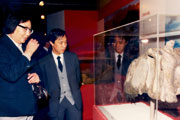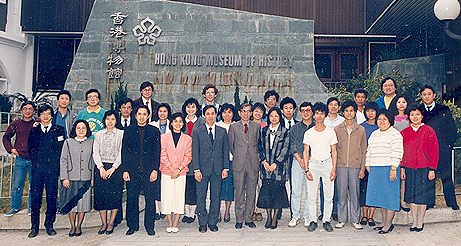Special Article
A Review of the Development of the Hong Kong Museum of History in the Past 30 Years (3): From a Small Gallery to a Fully Built Museum
Mr Ho Ching-hin
Former Chief Curator, Hong Kong Museum of History
2005
This year the Hong Kong Museum of History celebrates its 30th anniversary. Judging from the Museum's present scale and its ever growing audience, it has truly come of age.
I remember that when I first switched from teaching to working in the City Museum and Art Gallery perched at the top floors of the City Hall High Block, the history section was then a small part of the whole set-up. The Museum then was still administered in ways similar to small English towns, where the local museum and public library are lumped together, as an attachment to the city hall. Needless to say, both the exhibition and storage facilities were inadequate, and the few history or ethnography exhibitions had to wait for their turn after other art exhibitions. At that time, my mind was occupied by the wish to let the history section have its own space for development. However, limited by objective restrictions, during the early years I could only focus on building up the collections, followed by exhibitions whenever possible. The collections of traditional fishing junk models and local puppetry were developed during those years, through many field trips which I took together with the late Mr Robert P. F. Lam, who was most helpful in reaching out to various sources. Aside from the collections items, the most precious acquisition was the friendship of old fishermen, junk builders and artisans, as well as local puppeteers, who provided us with valuable information on the items collected.
In July 1975, the Museum of History made her debut in a rented space of about 700 m2 at Star House, Tsim Sha Tsui, while the storage and offices were located in a refurbished barrack building in nearby Kowloon Park. Looking back, the former Urban Council really made a daring move. The exhibition space was a far cry from any standard museum gallery, no matter in ceiling height, area, visitors' circulation or climatology. At the same time, the old barrack building, even after refurbishment and installation of air conditioning, fell short of the proper environment required for museum storage. We had to double our effort in putting up exhibitions and managing the collection. Even then, under those unfavourable conditions, the Museum gradually built up its collections and presented exhibitions which attained considerable popularity. Robert Lam's numismatics and philately exhibitions were literally "door crashers" (Within two months of our opening, we had to replace two of our glass doors broken by the crowd).While in traditional fisheries and farming displays, it was really encouraging to see older visitors who had experience in fishing or farming explain to their children how to operate the fishing junks or cultivate rice fields. Observing the visitors' response, I was deeply aware that a museum's success depended on its ability to reflect the life and experience of the audience, and I also fully realized how inadequate the museum facilities were at that moment.
Starting from the 1980s, most of my time was spent on the planning of a permanent home for the museum. After many attempts and setbacks, the Museum was able to step out of the rented premises in Star House in 1983, and moved into a better premises in two renovated barrack blocks in Kowloon Park. Inside this temporary Museum, special exhibitions such as "Made in Hong Kong" and "Traditional Chinese Wedding" were presented, as well as large scale loan exhibitions such as "Fossil Man in China" and "Dinosaurs in China". These exhibitions attracted large crowds, showing that Hong Kong really needed a permanent history museum. However, because the government had to develop the permanent art and science museums in the meantime, the Museum of History could only take an interim solution: to open a new wing in 1989. The new wing enabled the installation of the first long-term exhibition on Hong Kong history, "The Story of Hong Kong". The exhibition displayed its themes and related collection items through the help of reconstructed street scenes, multi-media devices and interactive exhibits, allowing visitors to experience, in the limited exhibition space, the many ups and downs in Hong Kong history.
After many years' efforts and planning, the permanent Museum of History at the Chatham Road site finally became a government public works item in 1995, and construction started as planned. In the same year I retired, feeling greatly relieved that a long-time dream was about to come true, and handing the task over to Dr Joseph Ting, the present Chief Curator, with the support of his excellent team. The Hong Kong Museum of History is now a fully-fledged museum in a purpose-built building, with comprehensive collections, excellent long term exhibitions as well as special loan displays. It has all the necessary supporting facilities, and is such a difference from the small, barely equipped "museum" at Star House. Aside from the well-developed hardware, the present Museum is now operated by staff members who have adequate professional training, and who are able to provide a wide range of services to the visitors. It is also hoped that our citizens and visitors treasure the Museum by visiting it and its branch museums more often, because it is their support and participation that give life to the Museum.
Finally, may I wish that the Museum, now moving into its fourth decade, will become even more mature and ready for greater challenges in the 21st century.

Mr Ho Ching-hin guiding the guests to tour the "Dinosaurs in China" exhibition in 1985

Group photo of the Museum staff in 1987, with Mr Ho Ching-hin (sixth from left in the front row) and Mr Robert Lam standing next to him.




